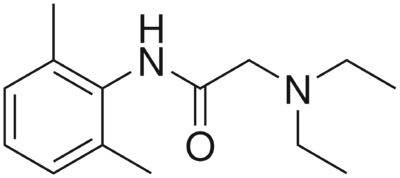Lidocaine
| Lidocaine | |
|---|---|

| |
| Other names | Lignocaine, Xylocaine |
| Drug class | Amino amide local anaesthetic |
| Maximum dose | 4.5 mg/kg with plain lidocaine 7 mg/kg with adrenaline Note max dose varies between use cases, e.g. intercostal block safe dose is 10 times less.[1] |
| Onset of action | Infiltration and minor nerve: 1-2 mins. Intra-articular: 5-10 mins Major nerve blocks:15-30 mins[2] |
| Duration of action | Infiltration and minor nerve: 1.5 - 2 hours Intra-articular: 30-60 mins post washout Major nerve blocks: 1.5 - 3 hours Duration longer with adrenaline.[2] |
| Chemical structure | 2‐(diethylamino)‐N‐(2,6‐ dimethylphenyl) acetamide hydrochloride monohydrate |
Lidocaine was the first clinically used amide local anesthetic in 1948. It is widely used because of its potency; rapid onset; tissue penetration; and effectiveness in infiltration, peripheral nerve block, and both epidural and spinal blocks. In peripheral nerve blockage 1-1.5% is sufficient to produce a motor blockade, while for epidural and spinal blocks higher strengths are used.
Chemical Structure
Formulations
Lidocaine Cream
Lidocaine cream is not readily available in New Zealand and is not subsidised. It has to be ordered over the internet.
- Haim International for 10.56% lidocaine cream, apply twice daily
- 4% Lidocaine patches can be purchased from ebay, brand name is Salonpas. They last for 8 hours.
Toxicity
- Main article: Local Anaesthetic Toxicity
The central nervous system is where the premonitory signs of toxicity occur, and it is a graded response. Early symptoms include circumoral numbness, tongue paraesthesia, and dizziness. Patients may complain of sensory disturbance such as tinnitus and blurred vision. There may be excitatory signs, such as restlessness, agitation, nervousness, or paranoia. These may progress to muscle twitching and seizures. With severe toxicity, CNS depression can occur with coma.
Cardiovascular effects with hypotension and bradycardia can occur as a result of a relative overdose with neuraxial blockage or nerve blocks nerve the CNS. Unintentional intravascular injection produces severe cardiotoxic reactions which include hypotension, atrioventicular heart block, idioventricular rhythms, ventricular tachycardia, and ventricular fibrillation. Even premonitory signs can progress to cardiotoxicity and so any reaction should be treated promptly.[3]
See Also
References
- ↑ Golzari et al.. Lidocaine and pain management in the emergency department: a review article. Anesthesiology and pain medicine 2014. 4:e15444. PMID: 24660158. DOI. Full Text.
- ↑ 2.0 2.1 https://www.medsafe.govt.nz/profs/Datasheet/l/lidocaineclarisinj.pdf
- ↑ Torp et al.. Lidocaine Toxicity. 2021. . PMID: 29494086.
Literature Review
- Reviews from the last 7 years: review articles, free review articles, systematic reviews, meta-analyses, NCBI Bookshelf
- Articles from all years: PubMed search, Google Scholar search.
- TRIP Database: clinical publications about evidence-based medicine.
- Other Wikis: Radiopaedia, Wikipedia Search, Wikipedia I Feel Lucky, Orthobullets,


